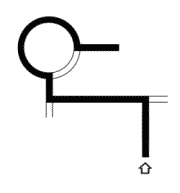This is a very old article, and they no longer use maps – it was the precursor to using a satnav.
I get a large amount of traffic based around the above search term. It’s so long since the introduction of the Independent Driving (ID) section of the test – more than a year ago – that it confuses me a little that the ID maps are still such a popular search item.
I am in the East Midlands, and 99.9% of those doing the searching are not.
Most ADIs must know by now what the ID section consists of, and even if they’re newly-qualified then they’d have seen the maps (or samples of them)during their training.

The maps used by driving examiners look roughly like the one here – and this is one of those released by the DSA as a sample some time before ID was introduced in October 2010. They’re simple line drawings, not Ordnance Survey maps or anything like you’d find in an atlas. And they only include two or three hazards (the one here has a left turn, a right turn, and a roundabout). They’re not intended to be anything more than schematics of a simple and very short route.
The actual maps – like the actual test routes – are not published, and I’d argue that any ADI who attempted to catalogue them (or even teach them specifically) is a very poor instructor.
From what I’ve seen, some instructors go to incredible lengths to make the diagrams they use on lessons look exactly like the ones the examiners use. They even go so far as to put on hi-vis yellow jackets and make copies of driving test marking sheets fixed to clipboards so they can conduct mock tests as if they were real examiners! Honestly, they do! Is it any wonder pupils get worried about how difficult it is to “read maps” for the ID section when someone is making it seem so dramatic?
My approach is to treat the whole business of ID as a matter-of-fact affair.
To start with, although I know a few of the ID routes from having sat in on a few tests (plus what my other pupils have told me about the routes they went on), I don’t teach those routes specifically. Even if I do happen to cover one on a lesson, I just say that the test could pass through this area.

When I decide to do a session on ID using a map (and it doesn’t have to be a whole lesson, either – it only takes about 10 minutes), I get the pupil to pull over somewhere, and then I sketch a simple line map like the one on the left (I drew this one just now for the purposes of this article).
It absolutely does not need to be an identical copy to those the examiners use.
The directions would go something like “we’re parked here [the dot]. I want you to drive on and turn right, third exit, at the roundabout. Then, turn left on to the main road. Follow the road to the next roundabout, then turn left, first exit”. I will perhaps add “and then follow the signs to…” at the end, because that’s what the examiners can do.
Obviously, and especially if it’s the first time we’ve covered ID, I will explain that if they aren’t sure which way to go, then they should ask. Then I will confirm the route.
I explain that that’s exactly what they should do on their tests, because it isn’t a test of their navigational skills or ability to remember a route. All they have to do is ask “was it left or right here” and the examiner will tell them. Their task is to negotiate the junction or hazard correctly (mirrors, signal, etc.), because that’s what they’ll have to be doing the following day if they pass!
The candidate could be asked just to follow road signs.
It would appear that examiners are not routinely using the maps anymore – though pupils can ask to see them. ( EDIT: I’ve sat in on two tests in late-2012 and I can assure you examiners ARE using them).
ID has made the driving test much, much easier, and my only complaint is that candidates do just one manoeuvre now. The vast majority of candidates have absolutely no trouble with ID. Indeed, the latest statistics from the DSA (see the link above) would indicate that pass rates have gone up as a result of it.
Those going to test should recognise that being nervous is not a sign that you can’t drive or that ID is a bad thing. Nerves are completely natural.when no one is telling you what to do (i.e. on the ID part of the test), and it’s not a sign that ID is difficult or unfair. Far too many people (including ADIs) think it is, though.